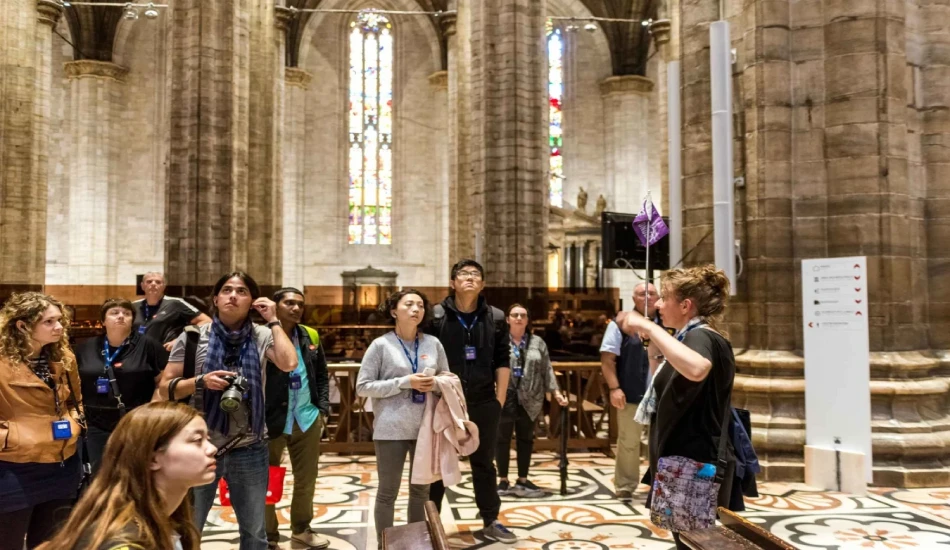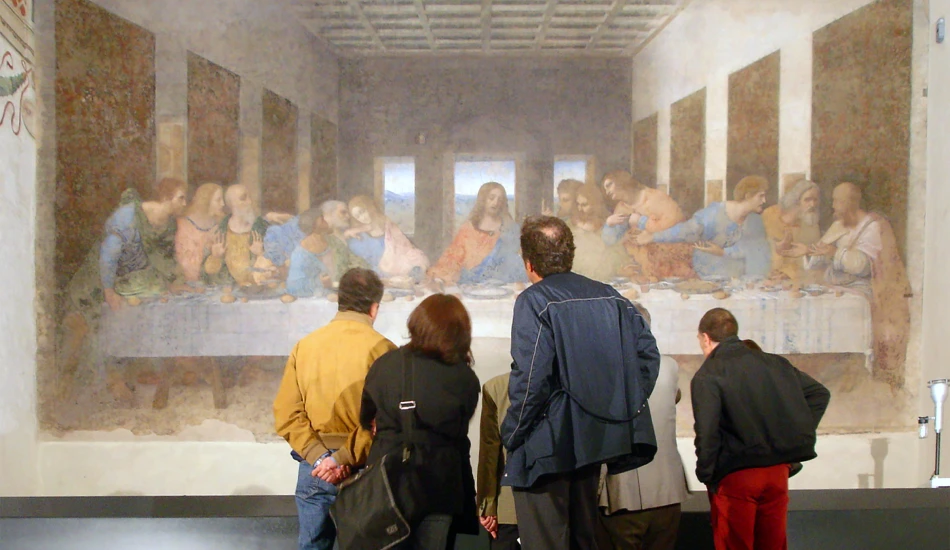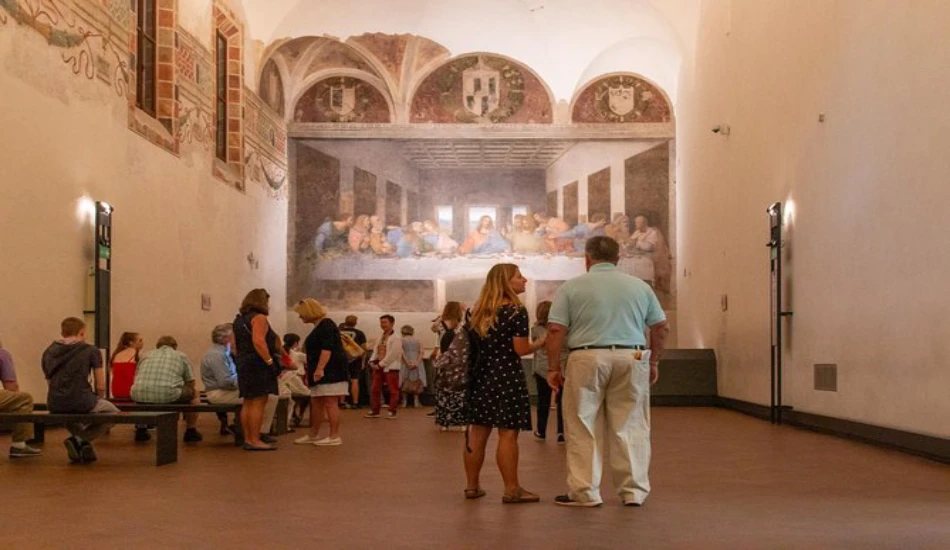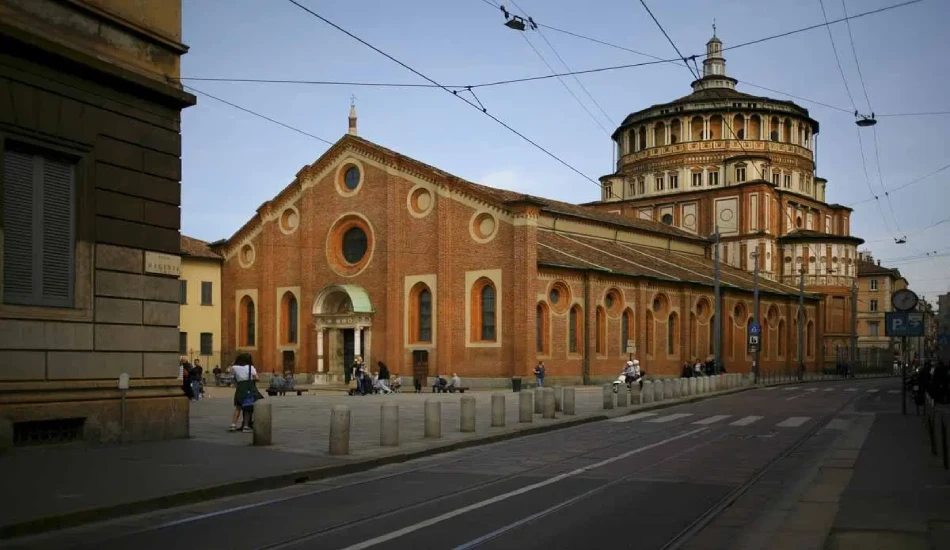You don’t want to travel all the way to Milan only to find The Last Supper sold out, the church unexpectedly closed, or the entrance hard to find.
Unfortunately, that happens more often than you’d think.
This guide helps you avoid those mistakes with 13 helpful tips for visiting Santa Maria delle Grazie to make your visit smooth, meaningful, and stress-free.
- Book The Last Supper tickets early – they sell out fast
- Guided tours can help if tickets are sold out
- The church itself is free and absolutely worth visiting
- Combo tickets can save you time and money
- Check if you qualify for discounted tickets
- Free entry is available on the first Sunday of each month
- Visit between 3 pm and 4.30 pm to avoid crowds
- Arrive at least 30 minutes early for your time slot
- Set aside at least 2.5 hours for your full visit
- Wear good shoes! You’ll be doing some walking.
- Don’t expect detailed explanations on-site
- Don’t confuse the church entrance with the mural entrance
- Use public transport – it’s easier than driving
Book The Last Supper tickets early – they sell out fast
If you want to see The Last Supper, you need to reserve your ticket online in advance.
Only 40 people are allowed in the refectory every 15 minutes, and slots disappear quickly, especially during holidays and weekends.
Many visitors make the mistake of showing up without booking and end up missing the mural entirely.
To be safe, book 2–4 weeks ahead.
Guided tours can help if tickets are sold out

Even if general admission tickets are gone, many guided tours include access to The Last Supper.
These are often the only way to get in at the last minute.
They also give you helpful context, including stories about da Vinci’s work and the church’s history, which you won’t get by just walking in alone.
It’s a smart choice if you want a deeper experience without worrying about logistics.
The church itself is free and absolutely worth visiting
You don’t need a ticket to enter the main church at Santa Maria delle Grazie.
It’s free and open to the public, with beautifully designed chapels, peaceful courtyards, and impressive Renaissance architecture.
Many people skip it, but it’s one of the most calming and authentic parts of the complex.
Even if you miss the mural, the church alone is worth your time.
RECOMMENDED
Why you must visit both di Milano and Last Supper church
Opening hours of Santa Maria delle Grazie
di Milano or Last Supper church – which is better?
Combo tickets can save you time and money
If you’re planning to see more of Milan, look for ticket packages that include Santa Maria delle Grazie, the Duomo, or Sforza Castle.
These combos often cost less than booking each attraction separately.
Some also include guided city tours or skip-the-line entry.
They’re ideal if you’re in Milan for just a day or two.
Check if you qualify for discounted tickets

For all visitors aged 25 years and above, Leonardo’s Last Supper tickets are priced at €15, while for youngsters aged 18 to 25, it is €2. Children under 18 enjoy free admission to the refectory.
School teaching staff with proper certification can also enter the refectory for free.
Always bring valid ID or proof when claiming these discounts.
It’s also wise to double-check eligibility on the official website before booking.
Free entry is available on the first Sunday of each month
On the first Sunday of every month, The Last Supper is free to visit, but you still need to book your slot in advance from the official website.
Tickets are released online on Wednesday at 12 pm and get finished quickly.
If you manage to get one, arrive early as it can get crowded.
This is one of the best ways to save money, but it requires quick planning.
Visit between 3 pm and 4.30 pm to avoid crowds
The church and museum tend to be busiest from mid-morning to early afternoon.
If you prefer a quieter visit, plan to arrive between 3 pm and 4.30 pm.
This is when the crowd usually thins out and the lighting is ideal for photos.
Early evening is also a peaceful time to explore the church without noise or rush.
Arrive at least 30 minutes early for your time slot
Visitors are allowed only 15 minutes in front of The Last Supper, and entry is strictly timed.
If you’re late, even by a few minutes, you may be denied entry.
Arriving early gives you time to find the correct entrance, go through security, and check in calmly.
Don’t risk losing your spot by cutting it too close.
Set aside at least 2.5 hours for your full visit

Although the mural viewing is only 15 minutes, seeing the whole complex takes time.
You’ll want to explore the church, the convent areas, and the peaceful courtyards without rushing.
If you’re on a guided tour, factor in a little extra time for commentary and walking.
A relaxed 2.5 to 3 hours is just right.
Wear good shoes! You’ll be doing some walking.
From the nearest metro stations to the church entrance, and throughout the complex itself, expect to walk a fair bit.
The floors inside are uneven in places, and there’s no seating in the viewing area.
Good footwear makes a noticeable difference. It’s a small but important thing that improves your visit.
Don’t expect detailed explanations on-site
The museum and church don’t have much signage or information in English.
If you want to understand what you’re looking at, especially the painting, you’ll need to read up beforehand or take a guided tour.
Many tourists walk away feeling like they missed something because they weren’t prepared.
A little research goes a long way.
Must Read: What to see at Santa Maria delle Grazie
Don’t confuse the church entrance with the mural entrance

Many first-time visitors assume the church and museum share an entrance, but they don’t.
The mural is housed in the convent’s refectory, which has a separate entry and its own queue.
Signage isn’t always obvious.
Ask a staff member if you’re unsure, especially if you’re on a tight schedule.
Use public transport – it’s easier than driving
Driving in this part of Milan can be frustrating.
The church is located inside a limited traffic zone (ZTL), and parking nearby is scarce and expensive.
The easiest route is by metro. Take the Red Line to Conciliazione or Cadorna, both just a short walk away.
Tram 16 also stops right outside the church.

